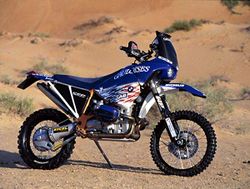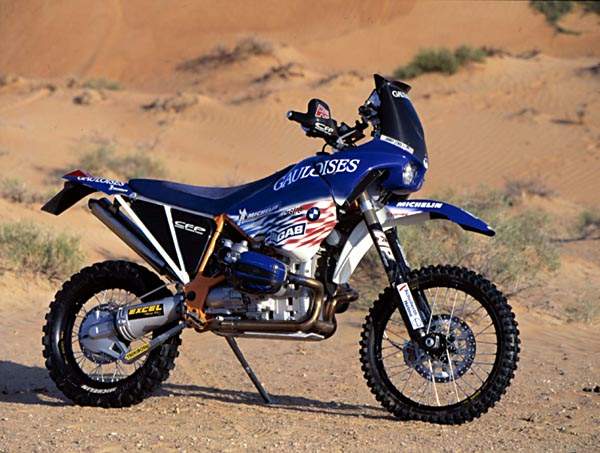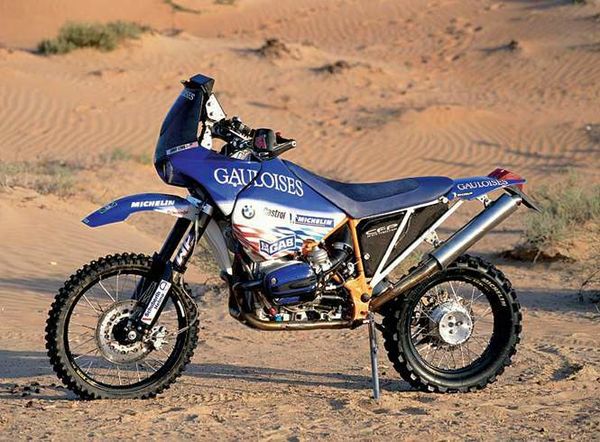BMW R900RR Dakar
 |
|
| BMW R900RR Dakar | |
| Manufacturer | |
|---|---|
| Production | 2000 |
| Engine | Four stroke, two cylinder horizontally opposed Boxer, 4 valves per cylinder |
| Transmission | 5 Speed |
| Suspension | Front: ∅48mm WP Forks Rear: WP mono shock |
| Brakes | Front: Single ∅300mm disc, 4 piston caliper Rear: Single ∅285mm disc, 4 piston caliper |
| Front Tire | 90/90 - 21 |
| Rear Tire | 140/80 - 18 |
| Seat Height | 995 mm / 37.6" |
| Weight | 190 kg / 419 lbs (dry), |
| Fuel Capacity | Main front: 30 L/ 7.9 US galSide (right): 10 L / 2.6 US galUnderseat: 3 L / 0.8 US gal (water) |
| Manuals | Service Manual |
Engine[edit | edit source]
The engine was a Air cooled cooled Four stroke, two cylinder horizontally opposed Boxer, 4 valves per cylinder.
Chassis[edit | edit source]
It came with a 90/90 - 21 front tire and a 140/80 - 18 rear tire. Stopping was achieved via Single ∅300mm disc, 4 piston caliper in the front and a Single ∅285mm disc, 4 piston caliper in the rear. The front suspension was a ∅48mm WP Forks while the rear was equipped with a WP mono shock. The R900RR Dakar was fitted with a Main front: 30 L/ 7.9 US galSide (right): 10 L / 2.6 US galUnderseat: 3 L / 0.8 US gal (water) fuel tank. The bike weighed just 190 kg / 419 lbs.
Photos[edit | edit source]
Overview[edit | edit source]
BMW R 900RR Rally
At the end of 1998, the management of BMW's Motorcycle
Division decided to run "Boxers" in rallying in order to have a means of
comparing two alternative design concepts.
A well-known specialist company, HPN, which had built the winning BMW bikes back in the 1980s, was asked to develop a competitive rallying version as a prototype. The main features were to be, in addition to retention of the bike's classic visual features, optimum weight distribution and enormous endurance potential.
In April 1999 BMW Motorcycles ran one of these prototypes in the Tunisia
Rally, in order to compare it directly with rival bikes and reveal its
strengths and weaknesses.
Although a 34th place in this event was only a modest result, it was evident that the project showed considerable promise and that there was no call for resignation.
During the summer of 1999 the bike's handling was extensively revised. Weight distribution was improved and the unsprung weight of the shaft drive and rear suspension reduced.
Numerous tests were carried out and it was obvious that progress was being made. The proverbial reliability of this bike as a whole was obvious from the Tunisian Rally result.
A further direct comparison with the competition took place in the Dubai Rally, held in November 1999. A new member of the team, the English rider John Deacon, achieved a highly satisfying 4th place in the overall ratings and thus demonstrated what the "Boxer" is capable of.
Once again, many detail design features have had to be modified if the bike is to have a good chance of success in the forthcoming Dakar Rally.
John Deacon and the other newcomer to the team, Jimmy Lewis from the USA, are particularly impressed by the bike's surprisingly agile handling and the seemingly unlimited power from its engine.
Reducing the engine size to 900 cc in order to comply with the rules for this rally seems to have had no adverse effects. Engine specialist Helmut Mader from Erding, near Munich, had no difficulty in satisfying BMW's demand for a healthy 90 horsepower from this engine, an output that gives it wings when the track opens out enough for high speeds to be reached. In its latest guise, looking great in its new "Gauloises blue" outfit, our twin-cylinder bike is not only a serious rival to the single-cylinder brigade but a visually attractive one as well.
The trade press has been full of praise for this new "Boxer" and has recalled the successes which the earlier versions once achieved.
| Make Model | BMW R 900RR Rally |
|---|---|
| Year | 2000 |
| Engine Type | Four stroke, two cylinder horizontally opposed Boxer, 4 valves per cylinder |
| Displacement | 900 cc / 54.9 cu in. |
| Cooling System | Air cooled |
| Induction | 2 x Bing constant speed carburetors |
| Starting | Electric |
| Max Power | 66 kW / 90 hp @ 8200 rpm |
| Transmission | 5 Speed |
| Final Drive | Shaft |
| Front Suspension | ∅48mm WP Forks |
| Front Wheel Travel | 300 mm / 11.8" |
| Rear Suspension | WP mono shock |
| Rear Wheel Travel | 300 mm / 11.8" |
| Front Brakes | Single ∅300mm disc, 4 piston caliper |
| Rear Brakes | Single ∅285mm disc, 4 piston caliper |
| Front Tire | 90/90 - 21 |
| Rear Tire | 140/80 - 18 |
| Seat Height | 995 mm / 37.6" |
| Dry Weight | 190 kg / 419 lbs |
| Fuel Capacity | Main front: 30 L/ 7.9 US galSide (right): 10 L / 2.6 US galUnderseat: 3 L / 0.8 US gal (water) |

